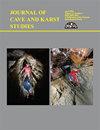基于耐热性和抗脱水性的全球气候危机对肯塔基州达林顿洞甲虫的影响
IF 0.5
4区 地球科学
Q4 GEOSCIENCES, MULTIDISCIPLINARY
引用次数: 0
摘要
由于目前的气候危机,气温上升和地下水供应减少,预计将使北美东部的洞穴动物暴露在前所未有的环境条件下,这可能对其独特的生态系统有害。众所周知,生活在洞穴等相对稳定环境中的生物会产生狭窄的生理耐受性。洞穴栖息地及其生物是简单的生态系统,其同质性为测试高度特化的动物群耐受非生物变化的能力提供了理想的系统。我们在美国东部肯塔基州达林顿的瓦伦丁测试了一种洞穴专用甲虫的能力,以抵御未来环境的气候变化。我们将个体暴露在一系列相对湿度和温度下10天。这些数据强烈表明,肯塔基金龟的生存存在一个温度阈值,但它比在最近进化时间中没有波动的环境中所期望的更高的热耐受性,这表明了祖先表生金龟的残余生理特征。环境中相对湿度的降低导致了生存能力的急剧下降,这表明对恒定的高湿度环境的高度进化的专业化。在洞穴环境中,与温度相比,穴居动物能够生存的狭窄湿度阈值可能是一个更明显的限制因素。本文章由计算机程序翻译,如有差异,请以英文原文为准。
Consequences of the global climate crisis on the cave beetle Darlingtonea Kentuckensis Valentine based on thermal tolerance and dehydration resistance
Rising temperatures and diminishing groundwater availability due to the current climate crisis are predicted to expose cave faunas in eastern North America to unprecedented environmental conditions that could prove detrimental to their unique ecosystems. Organisms that inhabit relatively stable environments like caves are known to develop narrow physiological tolerances. Cave habitats with their organisms are simple ecosystems whose homogeneity offers an ideal system for testing the ability of a highly specialized fauna to tolerate abiotic changes. We tested the capability of a cave-specialized beetle in the eastern United States, Darlingtonea kentuckensis Valentine, to withstand future climatic shifts in its environment. We exposed individuals to a range of relative humidities and temperatures for 10 days. The data strongly suggest that there is a temperature threshold for the survival of D. kentuckensis, but it is a higher thermal tolerance than would be expected in an environment that has not fluctuated in recent evolutionary time and suggests remnant physiological characteristics of ancestral epigean carabids. Decreasing the relative humidity in the environment resulted in a much more dramatic decline in survival, indicating highly evolved specialization for constant high-humidity environments. The narrow humidity threshold in which troglobionts can survive may be a much more apparent limiting factor than temperature in adapting to climatic shifts within a cave environment.
求助全文
通过发布文献求助,成功后即可免费获取论文全文。
去求助
来源期刊

Journal of Cave and Karst Studies
地学-地球科学综合
CiteScore
1.90
自引率
0.00%
发文量
6
审稿时长
>12 weeks
期刊介绍:
The Journal of Cave and Karst Studies is a multidisciplinary journal devoted to cave and karst research. The Journal is seeking original, unpublished manuscripts concerning the scientific study of caves or other karst features. Authors do not need to be members of the National Speleological Society, but preference is given to manuscripts of importance to North American speleology.
 求助内容:
求助内容: 应助结果提醒方式:
应助结果提醒方式:


